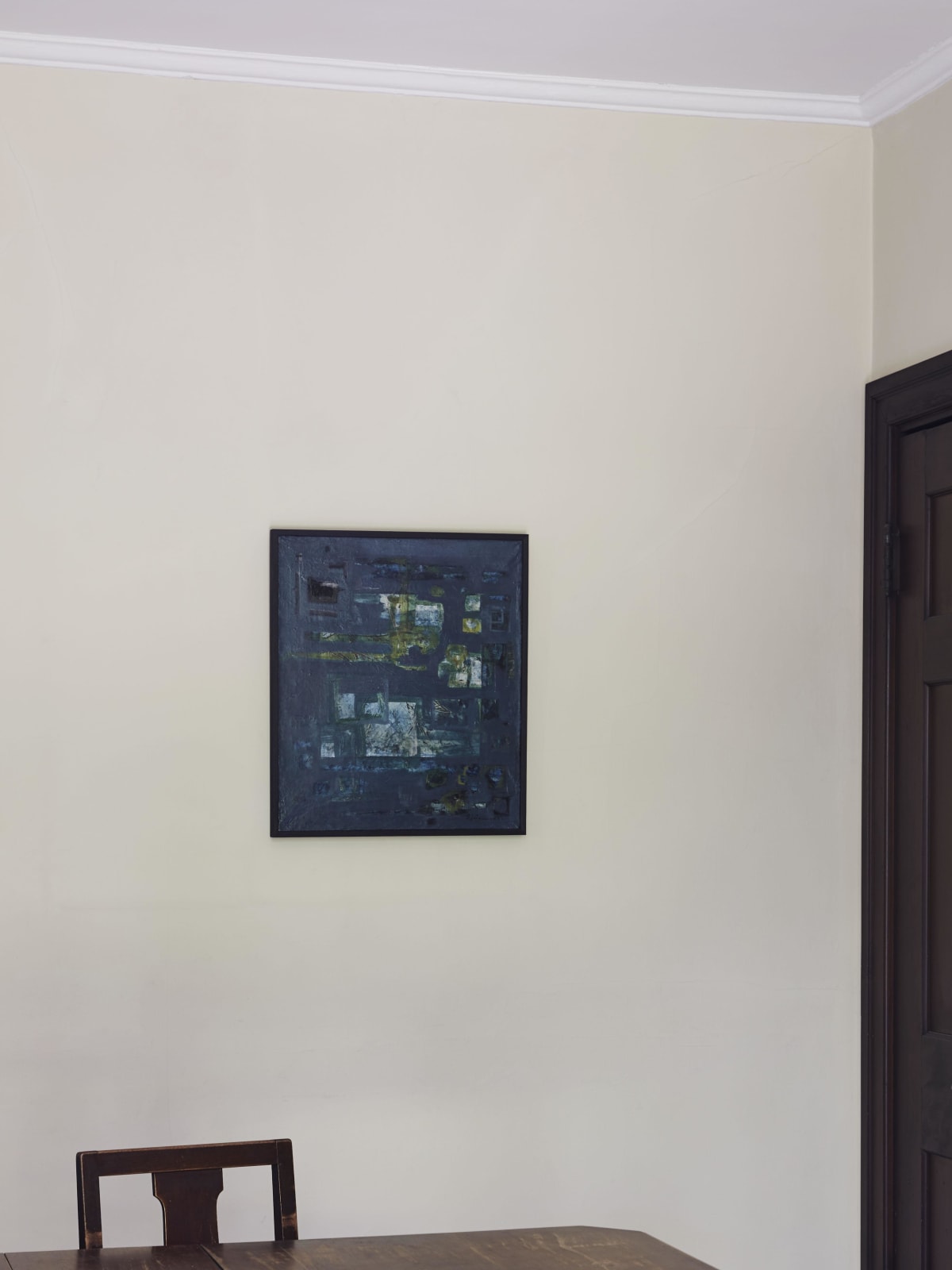Shimamoto Shōzō (1928–2013)
Work
Oil on newspaper, framed (10F)
53.3 x 45.8 cm
55 x 47 cm (overall)
53.3 x 45.8 cm
55 x 47 cm (overall)
Further images
Shimamoto Shozo first met Yoshihara Jiro in 1947. While other artists and intellectuals were still struggling in search of their artistic direction, Yoshihara had concretized the concept of artmaking as an act of freedom and a rite of destruction to create something new, which inspired Shimamoto and the members of Gutai Art Association. In a 1985 interview, Shimamoto recalled an early meeting with Yoshihara; it made him realize for the first the possibilities inherent in his mentor’s teachings:
At that time, between 1948 and 1949, I didn’t have money to buy canvas, so I used newspaper, gluing it together with laundry starch. I knew Yoshihara was a busy man, therefore I arranged an appointment beforehand. As I was quite ambitious, I brought five or six large works and a few smaller ones. I was worried to be late, so I rushed. Because of the hurry, one of the painting got damaged. How stupid of me! I could not repair it right away. What a disaster. Wait! No one said I could not have holes in my paintings. I took it with me and showed it to Yoshihara in fear. And he loved it just exactly the way it was.
This event triggered off the “Hole” series: a series in which the surface of each painting was pierced irregularly to reveal the different layers of newspaper underneath. Work: Holes in the collection of Museum of Contemporary Art Tokyo is an excellent example: the surface covered by the white paint, cracks and holes here and there, and the newspaper ground exposed. On the back of the present work as well layers of newspaper are visible. Though the letters are fading, we recognize the date of issue was of late November in 1951. These two facts – the date on the newspaper and the same technique used in both works – indicate the present work was likely executed in 1951, but before the time when he fully concentrated on unorthodox materials and techniques around the mid-1950s.
The present work arranges different geometrical patterns in an improvisational manner: rectangles and squares in the main, and a few triangles and circles in the surrounding areas. Square, triangle, and circle are elements that reminded us of Zen philosophy, an ideology that the later Yoshihara stronlgy identified with. By contrast, Shimamoto was inclined towards action and the spontaneity, like the well-known event at the outdoor Gutai exhibition of 1956, when he was throwing glass bottles full of paint at a large sheet of canvas.
Shimamoto Shozo (painter; 1928–2013)
Avant-garde artist born in Osaka. After earning his degree from Kansei Gakuin University, Shimamoto studied with Yoshihara Jiro, co-founding the Gutai Art Association in 1954. Among other unconventional approaches, Shimamoto explored brushless painting such as smashing bottles filled with paint against the canvas. He taught at the Kyoto University of Education and Takarazuka University of Art and Design (now Takarazuka University) and in his final years served as the chairman of the Japan Association of Art for the Disabled. Shimamoto was awarded the Medal with Dark Blue Ribbon in 1999.
At that time, between 1948 and 1949, I didn’t have money to buy canvas, so I used newspaper, gluing it together with laundry starch. I knew Yoshihara was a busy man, therefore I arranged an appointment beforehand. As I was quite ambitious, I brought five or six large works and a few smaller ones. I was worried to be late, so I rushed. Because of the hurry, one of the painting got damaged. How stupid of me! I could not repair it right away. What a disaster. Wait! No one said I could not have holes in my paintings. I took it with me and showed it to Yoshihara in fear. And he loved it just exactly the way it was.
This event triggered off the “Hole” series: a series in which the surface of each painting was pierced irregularly to reveal the different layers of newspaper underneath. Work: Holes in the collection of Museum of Contemporary Art Tokyo is an excellent example: the surface covered by the white paint, cracks and holes here and there, and the newspaper ground exposed. On the back of the present work as well layers of newspaper are visible. Though the letters are fading, we recognize the date of issue was of late November in 1951. These two facts – the date on the newspaper and the same technique used in both works – indicate the present work was likely executed in 1951, but before the time when he fully concentrated on unorthodox materials and techniques around the mid-1950s.
The present work arranges different geometrical patterns in an improvisational manner: rectangles and squares in the main, and a few triangles and circles in the surrounding areas. Square, triangle, and circle are elements that reminded us of Zen philosophy, an ideology that the later Yoshihara stronlgy identified with. By contrast, Shimamoto was inclined towards action and the spontaneity, like the well-known event at the outdoor Gutai exhibition of 1956, when he was throwing glass bottles full of paint at a large sheet of canvas.
Shimamoto Shozo (painter; 1928–2013)
Avant-garde artist born in Osaka. After earning his degree from Kansei Gakuin University, Shimamoto studied with Yoshihara Jiro, co-founding the Gutai Art Association in 1954. Among other unconventional approaches, Shimamoto explored brushless painting such as smashing bottles filled with paint against the canvas. He taught at the Kyoto University of Education and Takarazuka University of Art and Design (now Takarazuka University) and in his final years served as the chairman of the Japan Association of Art for the Disabled. Shimamoto was awarded the Medal with Dark Blue Ribbon in 1999.





